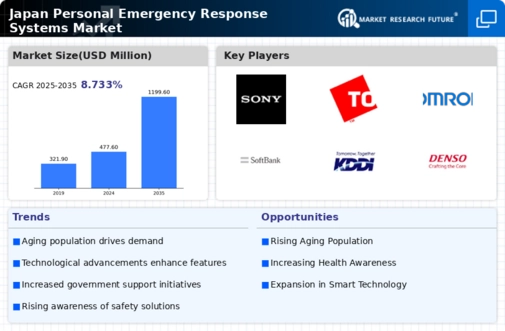Increased Urbanization
Japan's rapid urbanization is contributing to the growth of the personal emergency-response-systems market. As more people move to urban areas, the density of the population increases, leading to a higher likelihood of emergencies. Urban environments often present unique challenges, such as delayed emergency response times due to traffic congestion. This situation creates a pressing need for effective personal emergency-response systems that can provide immediate assistance. Market data suggests that urban areas are witnessing a 25% rise in the adoption of these systems, as residents seek to ensure their safety in densely populated settings. The personal emergency-response-systems market is thus poised for growth in urban centers.
Focus on Health and Wellness
The growing emphasis on health and wellness in Japan is influencing the personal emergency-response-systems market. As individuals prioritize their health, there is a corresponding increase in the demand for systems that can monitor health conditions and provide emergency assistance. This trend is particularly relevant for the aging population, where health-related emergencies are more prevalent. Recent statistics indicate that around 30% of older adults in Japan are using some form of personal emergency-response system to manage their health concerns. This focus on wellness is likely to drive innovation in the market, as companies develop systems that integrate health monitoring features with emergency response capabilities.
Integration of Smart Technology
The integration of smart technology into personal emergency-response-systems is transforming the market landscape in Japan. With the proliferation of IoT devices, systems that can connect to smartphones and home automation networks are becoming increasingly popular. This trend is evidenced by a reported 40% increase in sales of smart-enabled emergency devices over the past year. Consumers are drawn to features such as real-time monitoring and alerts, which enhance the effectiveness of emergency responses. As technology continues to evolve, the personal emergency-response-systems market is likely to expand, driven by the demand for innovative solutions that offer greater convenience and reliability.
Government Support and Regulations
Government support and regulations are playing a crucial role in shaping the personal emergency-response-systems market in Japan. The government has implemented various initiatives aimed at enhancing public safety, which includes promoting the use of emergency-response systems. Recent policies have encouraged the integration of these systems into public health strategies, leading to increased funding and resources for development. As a result, the market is experiencing a boost, with a reported 15% increase in funding for emergency-response technologies. This supportive regulatory environment is likely to foster innovation and growth within the personal emergency-response-systems market, as companies align their products with government standards.
Rising Awareness of Personal Safety
The increasing awareness of personal safety among the population in Japan is driving the personal emergency-response-systems market. As individuals become more conscious of potential emergencies, the demand for reliable response systems is likely to grow. This heightened awareness is reflected in surveys indicating that approximately 70% of Japanese citizens express concern about their safety, particularly among vulnerable groups such as the elderly. Consequently, manufacturers are focusing on developing user-friendly devices that cater to these concerns. The personal emergency-response-systems market is expected to see a surge in adoption as more people recognize the importance of having immediate access to help in emergencies.























Leave a Comment